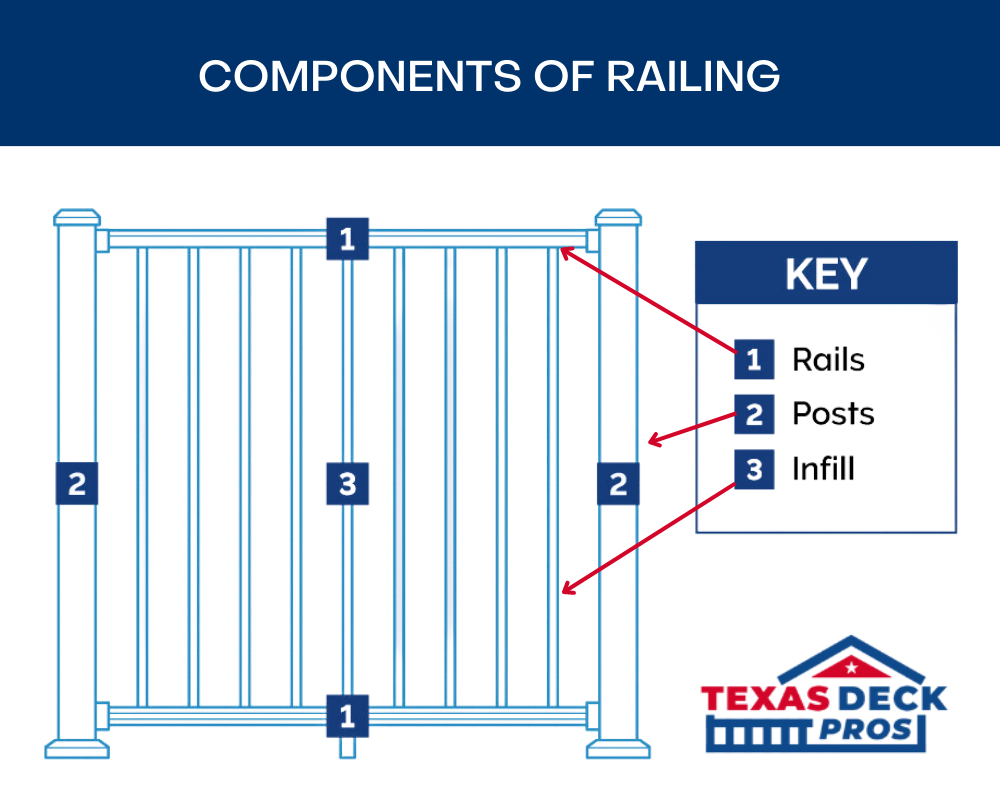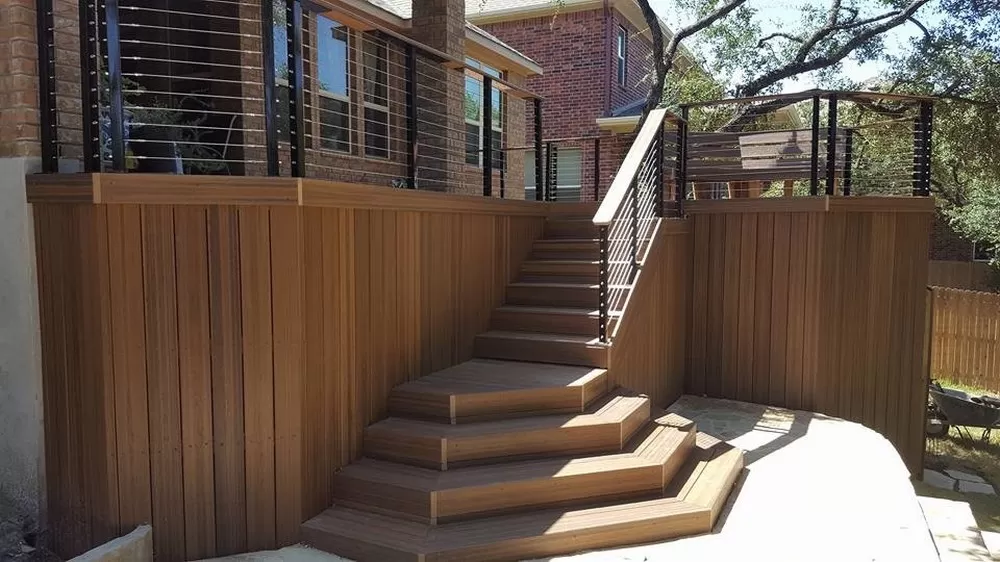Deck Railing Options
OUTDOOR RAILINGS
Learn more about all the deck and patio railing options for your San Antonio and surrounding area deck!
Schedule a Free Estimate Today!
The deck railing was once only considered a safety feature, but many homeowners are choosing to use it as an architectural element, even on projects that are not required. Railing visually finishes the deck and can add incredibly enhance your deck design.
DECK RAILINGS
Railing needs to fit your deck life. Are you looking for a scenic view? Have your deck match the style of your home?
- Metal rail panels connect to composite posts on this beautifully-designed round deck. Metal balusters have a slimmer profile than wood or composite.
- Chicken wire/coup gives an unobstructed view at a fraction of the cost of the cable railing.
- Cable rail has a sleek, contemporary profile and is made with a mix of metal, wood, or composite materials.
- White deck railing is trending again. Once only a classic look from Cape Cod, Colonial, or coastal gardens, it now fits with many design styles.
- Wood or composite railing posts are not as preferred because they block some views but are the most affordable option.

Cable Railing for Decks and Patios

Railing Components
Rails keep us safe and they prevent people and pets from falling off our deck or patio. The posts are the thick, vertical pieces that give your railing strength. The infill might be balusters (the vertical bars parallel to your posts). But railing can also use glass panels or metal cables as infill.
Posts
The posts on your deck railing do all the heavy-duty work to keep your railing upright, sturdy, and safe. The posts can hold up traditional balusters or spindles or provide the framework for a cable rail system or tempered glass panels.
Balusters, spindles, or cables
Most commonly used balusters and spindles run vertically along your railing, providing protection and visually defining the space.
Modern designer options include tempered glass or horizontal metal cables, which provide the same function yet don’t interfere with the surrounding view, so enjoy the scenery!
Handrail
The handrail runs across the top of the posts and balusters and has a comfortable grip. Some clients want a drinks rail with a flat top using a deck board for guests to set down their drinks while socializing.
Post caps or finials
Post caps or finials sit on the top of the post and add a decorative touch that can coordinate with your architecture or give the post a finished look. Trex composite railing offer posts with lighting included, or you can repeat the finials elsewhere in the home for a continuous design.
Types of Railing Materials
There are many types of railing, from wood, composite, metal, cables, glass, and many more ways to mix and match all of these. Each one has its own set of advantages and architectural styles go with.
Wood
A wooden railing is among the simplest options, and it also gives you a lot of flexibility since your contractor can construct something custom or mix and match pieces to get just the right look. Wood railing is affordable and goes best with wooden decks.
The downside of wood is that it needs regular maintenance, such as cleaning, staining, or painting, to stay structurally sound and continue looking good. Any special design features like curves and crevices of a wood railing can make it time-consuming.
Capped composite
The capped composite railing looks clean and fresh with very little ongoing maintenance. It is also right in the middle of all the options for the price. With so many Trex composite lineup options, you will find a style and color that works for you. This option worked with colonial, coastal, contemporary, and traditional homes. You can mix and match components like wood to customize the railing to your deck.
Metal
Various metal railings are available, but the most common are aluminum, galvanized steel, and iron. One of the advantages of using metal balusters is that they usually have a slimmer profile than composite or wood, so are less likely to block the view.
Cable Rail
While cable rail is a high-end option, with the materials costing $60 or more per linear foot, homeowners that treasure a view opt for this upgrade. The horizontal cables are attached to wooden or composite posts and have a sleek, clean look that goes beautifully with modern, contemporary farmhouses and simple landscapes.
Tempered glass
Tempered glass is an excellent option for landscapes with too much weather, like the wind. If you seek to enjoy the sunshine without the wind tossing your hair into knots, upgrading to tempered glass panels instead of balusters might be your best option.
Considerations When Choosing
Even if it’s not required, you might choose to install a railing just for the feeling of security. While it’s unlikely that you’d seriously injure yourself by stepping off a deck only 24 inches off the ground, a deck without a railing feels insecure and can be a less inviting place to spend your time.
More Photos
Download
Company Brochure
PDF | 13MB

HAVE ANY QUESTIONS?
Picking all the Components of your new outdoor space can be daunting. Let us assist you!















